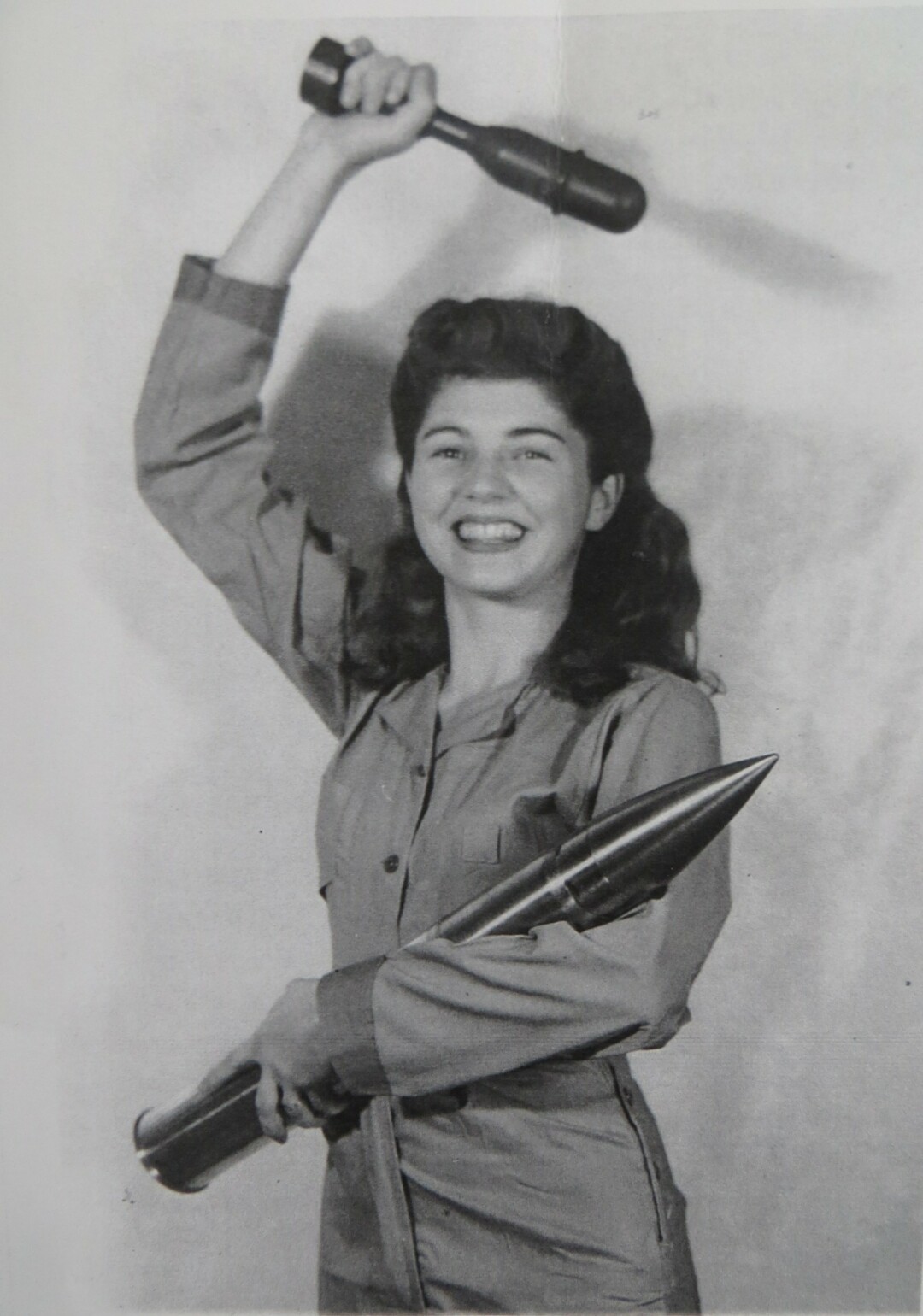
Eighteen-year-old Winifred “Winnie” Rubenzer didn’t run a rivet gun like “Rosie.” Instead she and her co-workers at the Eau Claire Ordnance Plant – many of them sisters, wives, or sweethearts of U.S. service members – served our country by making ammunition during World War II.
Winnie is 95, and she goes by Freddie Glass Jensen now. She shows me a portrait of herself as “Miss Victory,” featured on a poster to promote the war effort: she stands in her coveralls, rifle grenade raised over her head and 35mm shell clutched in her arm.
Freddie prepared for our meeting by calling her friend, Lillian, 96, who worked with her at two munitions plants. Freddie offers me a list with dates. August 1942: U.S. Rubber is bought by the government and converted to an ammunition factory, Eau Claire Ordnance Plant (now Banbury Place). July 1943: Young Winnie, a recent graduate of McDonell Memorial High School in Chippewa Falls, meets Lillian in a long line to apply at the ordnance plant. The two of them are hired as “inspectresses” in the Bullet Visual department and become fast friends. Soon Lillian changes her name to “Irish.”
“Because she was from Ireland?” I ask.
“No,” Freddie chuckles, “because she liked it.” Lillian/Irish inspired her. Freddie always hated the name “Winnie,” and not long after she befriended Irish, she met her first husband, George Glass, an Air Force cadet at the Eau Claire State Teachers College. That night Winifred decided to not so much change her name, but, as she says: “just use the rear end of it.” She’s been “Freddie” ever since.
When the plant closed in December 1943 (and returned to producing rubber), the two women set off on their next adventure: a transfer to the Green River Ordnance Plant. In January Freddie and Irish rode the bus to Dixon, Illinois, where for almost a year they slept in barracks and ate in a mess hall. “Just like soldiers,” she says. At first they admired the other women’s “brilliantly red hair,” but after using shared showers they realized that red hair was all over. Soon Freddie and Irish also had red hues, she suspects from the chemicals.
“We wondered what it did to our insides,” she says with a laugh. They worked in a large bay, filling rifle grenades with liquid pentolite. Freddie recalls one woman blew herself up when she crammed a shell into the line too forcefully. According to the National Park Service, factories were so dangerous that between the 1941 Pearl Harbor bombing and the 1944 D-Day invasion there were more industrial deaths than military casualties.
I ooh over the stunning teenaged Freddie as “Miss Victory.” Her photo appeared on posters around town and in newspapers throughout Illinois: “Bring those sons and sweethearts home … get out the ammunition at Green River Ordnance Plant.”
Freddie says, “Josie got a lot more copy than I did.”
“Rosie,” I correct.
Rosie the Riveter was propaganda; Freddie is reality. She worked in difficult circumstances to help win the war, married and raised five children, thrived as an executive secretary at Northwestern Bank, cared for her aging parents, volunteered in her community, added to the beauty of the world with her flowers and paintings, offered a hug when a person needed one, and always looked forward to her next challenge.
Ironically the most recognizable “Rosie” today was little-known in 1943. The “We Can Do It” poster was an internal campaign at Westinghouse Electric featuring a worker with her hair pulled up in a red polka dot kerchief, fist raised and bicep flexed. In the 1980s this Rosie became an iconic image of the women’s movement, particularly for “working women” and some unions. In 1999 she appeared on a postage stamp.
Syndicated journalist Alice Hughes wrote on July 14, 1943: “Probably the most popular pet name around the country for a woman factory worker is ‘Rosie the Riveter.’ ” Seventy-six years later, Freddie shows me her commendation from her supervisor on Eau Claire Ordnance Plant letterhead: “We have found her very efficient, courteous, and commendable.” These are admirable qualities for a woman entering the workforce, but many of these “Rosies,” like Freddie, evolved into so much more throughout their long careers: leaders, trailblazers, and mentors.
Since 2017, National Rosie the Riveter Day – March 21 – celebrates the 16 million women who joined the workforce during World War II. Today, any woman working outside of her home can thank those teen-through-middle-aged assembly line workers for leading the way. Each of them forever represents a small part of something big.
Patti See is a regular contributor to Sawdust Tales in the Leader-Telegram, where this essay was originally published. For more by and about Patti, follow this link.






















